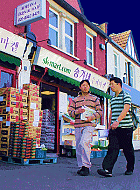|
London’s Korea Town, lying south-east of Norbiton. New Malden began to develop as a separate township from Kingston in the second half of the nineteenth century, boosted by the coming of the railway in 1846 and the opening of the Kingston
Loop in 1869. Until this time the area had fewer than a thousand inhabitants and consisted mostly of farms and smallholdings
separated from Kingston by Norbiton Common. The first roads to be laid out were the Groves, to the north-west of the station. New Malden became an urban district in
1894. Suburban development reached a peak in the 1930s and the town become a borough in 1936. New Malden has long had an industrial
element and was subjected to bombing during the blitz, which had the effect of clearing the way for more housing after the
war.
With around 10,000 Korean residents in the vicinity, New Malden has the largest and most concentrated Korean population in
Europe. No one is quite sure how this came about. One explanation is that 1970s Korean expatriates followed the example of
their ambassador and settled in Wimbledon, but when prices there rose excessively they decamped to nearby New Malden. The
community is served by its own shops, restaurants and other enterprises, and several local churches hold services in Korean.
The Anglo-Korean Cultural Institute is headquartered in Burlington Road. New Malden also has a sizeable Tamil community, originating
from Sri Lanka.
 |

